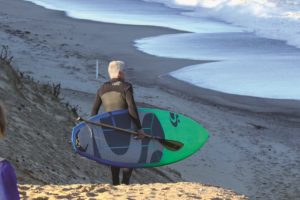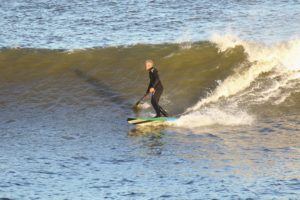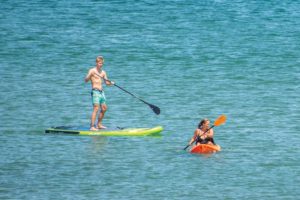People always ask me, “What’s the best exercise?” That’s a tough one because “best” can mean many different things. Is it the one that burns the most calories? Works the most muscles? Has the least risk of injury? I could come up with an answer based on any of those, but really the best exercise for you is the one you’ll actually enjoy — that means it’s one you will do.
My friend Jim O’Connell has helped me see this clearly. Jim does stand-up paddleboarding (known as SUP). He’s one of the fittest people I know, and one reason is that he’s out on the water year-round — he does it because he loves it.

He tells the story of his first time on a paddleboard. “I had gone to watch the sun rise and drink my coffee at Newcomb Hollow,” he says, “when I saw my friend Phil standing on a board and holding this long paddle. He asked me if I wanted to try. I did.”
Right then and there, Phil Clark lent Jim a wet suit and set him up on a board. “The sun was coming up and there were beautiful waist-high swells,” Jim says. “There were bass swimming all around me. It was magical. Two days later, I bought my first board.”
Almost every day, you can see Jim on the ocean side in Wellfleet paddling and surfing the waves. What is it that keeps him coming back? Jim says there’s a social aspect to it; he’s part of a regular group of SUP and surfing folks. He loves a party wave, where you ride in with your friends.
He also knows it’s good for him physically. And what he’s doing out there is a great total body workout. But beyond that, Jim says that it’s good for his mind. “Out there, I don’t think about anything,” he says. “I’m completely in the moment.”

What Jim is describing is also known as flow. (This use of the term was coined in the 1970s by Mihaly Csikszentmihalyi, who made a career of studying happiness and is considered one of the founders of what’s now called positive psychology.) Flow happens when a person’s entire being is absorbed by the activity at hand, distractions disappear, one move follows naturally from another, and time seems to slow down.
The beauty of flow is that it can shift your motivation from “I need to exercise to lose weight or lower my blood pressure” to “I want to do this because it makes me happy.” Tapping into flow has been shown to have psycho-emotional benefits such as improved focus, decreased stress, and increased happiness — as Jim says, “the whole package.”
You’re surely not going to read a how-to here, stand up on a paddleboard, and go. But I do have some suggestions on getting started. I hope a description of the basics will give you a sense of what it’s like:
- Rent or borrow a board so you can try before you buy.
- You need a couple of other pieces of gear: a paddle and leash, which attaches you to the board.
- For safety, start on flat water such as a pond; wear a life jacket and bring a safety whistle.
- Place the board in knee-deep water and get on the center on your hands and knees, then slowly get your feet underneath you. Rise to standing gradually — balancing on the water is challenging.
- Get a feel for balance: stand with your feet parallel and hip width apart, bend your knees, and gently shift your weight from side to side.
- Now you’re ready to paddle. If you’re holding the paddle on the right side of the board, grasp the top handle with your left hand and place your right hand down on the shaft. Make sure the blade angles away from you, toward the front of the board.
- Move from your core. Reach forward and place the blade in the water, push forward with your left hand as you rotate your body to the right, until the paddle is next to your ankle, then lift it out of the water and repeat.
- Straighten out. You’ll need to switch sides periodically to maintain a straight path — when you do, reverse your hand positions.
- Fall the right way. If — when — you lose your balance, try to hold onto your paddle and fall away from the board, rather than onto it.
If you want to learn more about technique, Jim recommends getting a lesson. If you fall in love with it the way he did, you’ll find you soon want to experiment with more challenging water. The Pamet River’s easy pace would be a gentle possibility. Then there’s the ocean. Surfing the waves like Jim does is the most challenging, so you would need to work your way up to that one.
But perhaps, somewhere along the way, whether it be SUP or something else, you’ll find that thing that makes your heart sing. When you do, you’ll know you’ve found your flow, and that’s the best exercise there is.

